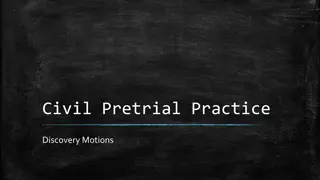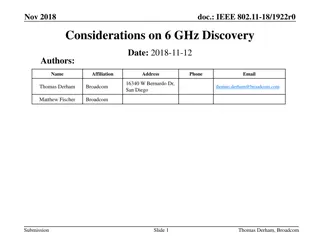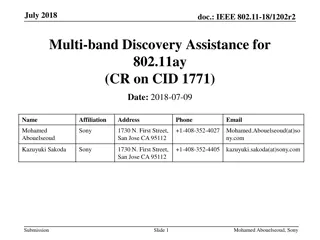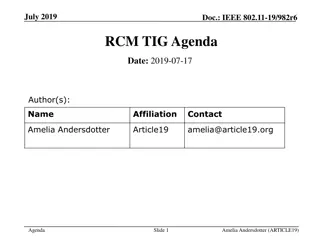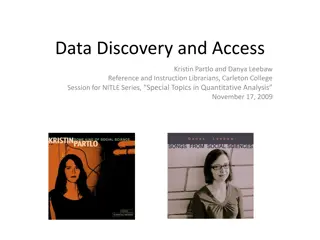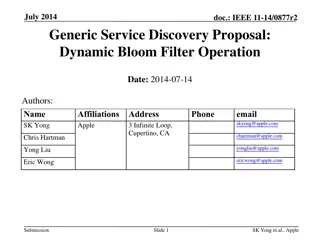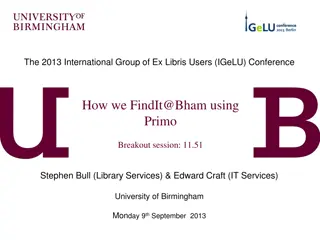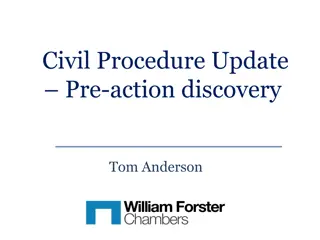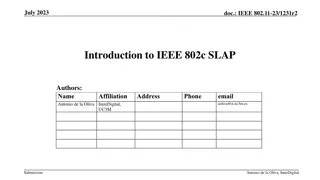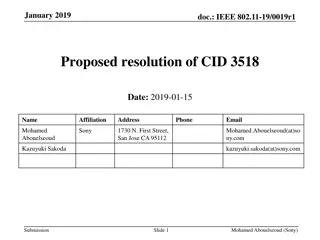Service Discovery for Local Services in IEEE 11-14/0124r0 Document
Elaboration on non-tethering Soft AP and possible service network scenarios in the January 2014 IEEE document. It discusses the concept of non-tethering Soft APs, their operation in the vicinity, and the categories of use scenarios related to Internet access and service discovery. The document covers STA connection states when performing Pre-Association Discovery (PAD) and Post-Association Discovery (Post-AD) for accessing specific services in the local network. It highlights the importance of PAD and Post-AD in assisting STAs to switch between different Basic Service Sets (BSSs) for required services.
Uploaded on Sep 11, 2024 | 1 Views
Download Presentation

Please find below an Image/Link to download the presentation.
The content on the website is provided AS IS for your information and personal use only. It may not be sold, licensed, or shared on other websites without obtaining consent from the author.If you encounter any issues during the download, it is possible that the publisher has removed the file from their server.
You are allowed to download the files provided on this website for personal or commercial use, subject to the condition that they are used lawfully. All files are the property of their respective owners.
The content on the website is provided AS IS for your information and personal use only. It may not be sold, licensed, or shared on other websites without obtaining consent from the author.
E N D
Presentation Transcript
January 2014 doc.: IEEE 11-14/0124r0 Service discovery for local services Date: 2014-01-18 Authors: Name Affiliations Address Phone email 1F, 6-3 Baoqiang Road, Xindian district, New Taipei City, Taiwan Jing-Rong Hsieh HTC Corp. jing_hsieh@htc.com Submission 1 HTC
January 2014 doc.: IEEE 11-14/0124r0 Abstract Elaboration on non-tethering Soft AP and possible service network scenarios Recap use case that STA already in association but trying to discover services which may not be provided in current BSS HTC Submission 2
January 2014 doc.: IEEE 11-14/0124r0 Non-tethering Soft AP Not access to Internet; provide service in near vicinity Usually operate in on-demand and temporary fashion Usually serve as AP by default Not convenient to change configuration Direct connection, no Advertisement Server No Group Owner negotiation May suggest the seeker STA updating the upper layer App Example Camera (Soft AP) Phone (non-AP STA) Submission 3 HTC
January 2014 doc.: IEEE 11-14/0124r0 Categories of use scenarios Pure Internet (AP and Internet-tethering Soft AP) Default for general users; no PAD is fine. External network service: *Post-AD is fine; PAD is helpful Internet + Service in near vicinity Post-AD is fine; PAD is helpful Mostly enterprise scenario (or home) No-tethering Soft AP (Specific service in near vicinity) Better have PAD as its service is specific The info should be compact to reduce overhead May not expose existence if the service does not match Power saving is essential *PAD: Pre-Association Discovery *Post-AD: Post-Association Discovery Submission 4 HTC
January 2014 doc.: IEEE 11-14/0124r0 STA connection state when performing PAD STA performs service discovery when requested by user May in unassociated state or in associated state A STA may associate with an Internet-accessing AP but need some services in vicinity not provided by the BSS Different from roaming (because of signal quality and subscription) between APs May need Post-AD to verify the presence of certain service if the info is unknown PAD for other APs Help STA make necessary switch between different BSSs regarding required services Post-AD and PAD Different in frame filtering (address 3) and types of frames (Data vs Public Action) allowed to be used Submission 5 HTC
January 2014 doc.: IEEE 11-14/0124r0 PAD for STA in association Neighbor report or reduced neighbor report only shows existence and capability information and may not reflect the network situation timely May use Wildcard PAM Not every STA needs to do PAD, but may need it later Post-AD and PAD at the same time Different from wildcard probe request which every AP needs to respond May still need to perform PAD in other channels Submission 6 HTC
January 2014 doc.: IEEE 11-14/0124r0 Summary An informative discussion about Soft AP and in- association service discovery for local services With efficient PAD, network selection should be as easy as, say, TV channel/source selection to attain good user experience Submission 7 HTC
January 2014 doc.: IEEE 11-14/0124r0 Appendix Submission 8 HTC
January 2014 doc.: IEEE 11-14/0124r0 Expect user to manually choose the right network first 1 2 2 1 however When user is using social network app, he/she does not actually care how the content is downloaded from H/3G/E or WLAN (switching because of signal quality, not because of service discovery) Current vendor designed working flow (without service discovery and automatic network selection) User behavior May lead to operation failure and user frustration Submission 9 HTC








